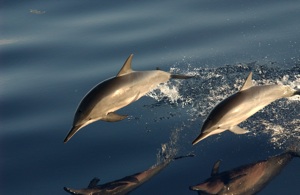Marine Mammal Species Description
Spinner Dolphin
Stenella longirostris
(Gray, 1828)

Photo credit: Wayne Hoggard NOAA/NMFS/SEFSC
Classification
Order: Cetacea
Family: Delphinidae
Alternate Common Names:
Status: MMPA Depleted
Description:
Length: 4-8 ft (1.3-2.4 m)
Weight: 48-176 lbs (22-80 kg)
One of the most recognizable features of the spinner dolphin is a behavior that they were named after. When they jump out of the water, they spin in the air (like a barrel roll) and land with a very large, loud splash. Male spinner dolphins tend to be slightly bigger than females. Spinner dolphins have a long beak, a triangular dorsal fin that is falcate or triangular. In some males, the dorsal fin appears backwards with the tip pointed forward. They have a dark gray back, gray sides, and a white belly.
Habitat:
Spinner dolphins use protected bays or harbors of islands or the coasts of the mainland during their resting time and move farther from shore when they are not resting. Researchers suggest that if protected bays are not available, spinner dolphins will join with schools of spotted dolphins for protection while they rest. Spinner dolphins occur in schools of a few individuals to thousands of individuals or mixed species schools with pantropical spotted dolphins (Stenella attenuata).
Feeding:
Spinner dolphins eat fish, squid, and shrimp. Spinner dolphins dive 660-980 ft (200-300 m) in pursuit of food. They have been documented diving up to 1,970 ft (600 m) for squid and other deeper dwelling food sources. When they feed at night, spinner dolphins have been documented cooperatively herding fish into groups to make feeding easier.
Reproduction:
Adult females reach sexual maturity at 4-7 years old and about 5.2-5.6 ft (1.6-1.7 m) in length. Males reach sexual maturity at 7-10 years old, at 5.2-5.9 ft (1.6-1.8 m) length. Females have calves about every three years. Gestation period lasts about 10.5 months. The calves are weaned in one to two years.
Other:
There are at least four recognized subspecies of spinner dolphin. Gray's spinner dolphins (Stenella longirostris longirostris) are the most common subspecies and is the subspecies seen in the Gulf of Mexico and coastal areas of the southeastern United States. The maximum life span documented for a spinner dolphin was 26 years.
Distribution / Range:
Spinner dolphins occur in tropical and subtropical waters worldwide. It occurs off the eastern coast of the United States and in the Gulf of Mexico.
Similar species:
Similar species include other long-beaked species of the genus Stenella, like Clymene dolphins (Stenella clymene).
Notes:
References:
American Cetacean Society. 2004. American Cetacean Society Fact Sheet. http://www.acsonline.org/factpack/SpinnerDolphin.htm. Accessed January 2012.
Culik, B. 2010. Odontocetes. The toothed whales: "Stenella longirostris". UNEP/CMS Secretariat, Bonn, Germany. http://www.cms.int/reports/small_cetaceans/index.htm. Accessed January 2012.
Hammond, P.S., Bearzi, G., Bjørge, A., Forney, K., Karczmarski, L., Kasuya, T., Perrin, W.F., Scott, M.D., Wang, J.Y., Wells, R.S. & Wilson, B. 2008. Stenella longirostris. In: IUCN 2011. IUCN Red List of Threatened Species. Version 2011.2. www.iucnredlist.org. Downloaded on 09 January 2012.
Perrin, W.F. 1999. Spinner dolphin, Stenella longirostris. In The Smithsonian Book of North American Mammals. Wilson, D.E. and S. Ruff, eds., 271-272. Smithsonian Institution in association with the American Society of Mammologists, Washington DC.
Perrin, W.F. 2009. Spinner Dolphin - Stenella longirostris. In: Encyclopedia of Marine Mammals 2nd Ed. Perrin W.F., B. Würsig, and J.G.M. Thewissen, eds. Academic Press, New York, pp. 1100-1103.

 Marine Mammals of Georgia
Marine Mammals of Georgia